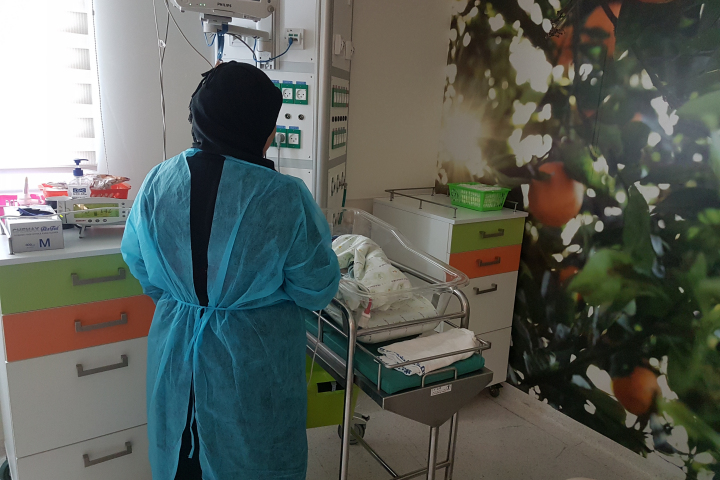A Syrian woman facing certain death from a high risk pregnancy entered Israel through the humanitarian gate and was treated at Rambam Health Care Campus in a special operation. Mother and son are back home and thriving.
 The Syrian woman visits with her child.
Photo Credit: Spokesperson's Office, RHCC
The Syrian woman visits with her child.
Photo Credit: Spokesperson's Office, RHCC
Yesterday, after two weeks hospitalization in Rambam's maternity ward, a young woman returned home, somewhere in the country to the north of Israel, determined and happy. Two weeks ago, doctors had offered a grim choice – to die at her son's imminent birth, or to let her son die. After examining the ultrasound results of her uterus, the Syrian doctor explained there were no other possibilities; her placenta had become entangled in the uterine muscles due to previous births that had ended in cesarean sections.
The Syrian doctor explained the terrible meaning of the ultrasound. A normal birth would be impossible and he was not willing to perform a cesarean section when almost certainly the mother or the baby would die. When the woman asked if there was anything she could do, he explained she could travel north to a modern hospital in Damascus or try to reach the Israeli border and request entry for medical treatment. She chose Damascus but was turned back at roadblocks due to the heavy fighting.
Nearing the end of her ninth month and refusing to accept the loss of her life or of her child, she said her goodbyes to her husband and children and headed south.
Two weeks ago, tired and in pain, she crossed the humanitarian border between Israel and Syria. A few days later she was admitted to the Mrs. Edith and Prof. Dov Katz High Risk Obstetrics Unit at Rambam Health Care Campus where Professor Ido Solt, Director of the Division of Maternal-Fetal Medicine in the Department of Obstetrics and Gynecology and an expert in high risk pregnancies, praised the diagnosis of his Syrian colleague who he would probably never meet. "A normal cesarean would have been impossible as you would have bled to death," he had explained to the mother, "we will have to do a more complicated procedure."
Professor Solt worked with colleagues in Rambam's Department of Vascular Surgery and Transplantation to develop a surgical approach suitable for a high-risk pregnancy, a procedure that would have been difficult to impossible to perform in Syria. Dr. Igor Kogan, an angiography expert in the Interventional Radiology Unit of the Department of Medical Imaging at Rambam, inserted two balloons into the mother’s uterine arteries—once inflated they would prevent bleeding during the procedure. After the delicate operation, Rambam physicians performed a cesarean section bringing a cute premature Syrian baby into the world. He was transferred to an incubator at Rambam's Department of Neonatology and Neonatal Intensive Care while his mother's womb was safely closed.
After a few days in the maternity ward while her baby overcame infections, all was well. The mother was thankful to be able to visit her son daily. She told the nurses that she missed her family very much, and that her husband, with whom she had not been in contact since she left home, did not know if she had survived the operation and or that he now had a new son. "I decided on the baby's name a long time ago," she says, "a son or a daughter's name. Now my husband will receive a wonderful surprise."

